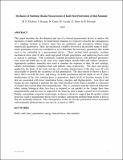| dc.contributor.author | Destrade, Michel | |
| dc.date.accessioned | 2013-01-16T15:29:16Z | |
| dc.date.available | 2013-01-16T15:29:16Z | |
| dc.date.issued | 2008 | |
| dc.identifier.citation | GILCHRIST, M.D., KEENAN, S., CURTIS, M., CASSIDY, M.: BYRNE, G., DESTRADE, M. (2008) 'Measuring knife stab penetration into skin simulant using a novel biaxial tension device'. Forensic Science International, 177 :52-65. | en_US |
| dc.identifier.issn | 0379-0738 | |
| dc.identifier.uri | http://hdl.handle.net/10379/3159 | |
| dc.description.abstract | This paper describes the development and use of a biaxial measurement device to analyse the mechanics of knife stabbings. In medicolegal situations it is typical to describe the consequences of a stabbing incident in relative terms that are qualitative and descriptive without being numerically quantitative. Here, the mechanical variables involved in the possible range of knife-tissue penetration events are considered so as to determine the necessary parameters that would need to be controlled in a measurement device. These include knife geometry, in-plane mechanical stress state of skin, angle and speed of knife penetration, and underlying fascia such as muscle or cartilage. Four commonly available household knives with different geometries were used: the blade tips in all cases were single-edged, double-sided and without serrations. Appropriate synthetic materials were used to simulate the response of skin, fat and cartilage, namely polyurethane, compliant foam and ballistic soap, respectively. The force and energy applied by the blade of the knife and the out of plane displacement of the skin were all used successfully to identify the occurrence of skin penetration. The skin tension is shown to have a direct effect on both the force and energy for knife penetration and the depth of out of plane displacement of the skin simulant prior to penetration: larger levels of in-plane tension in the skin are associated with lower penetration forces, energies and displacements. Less force and energy are also required to puncture the skin when the plane of the blade is parallel to a direction of greater skin tension than when perpendicular. This is consistent with the observed behaviour when cutting biological skin: less force is required to cut parallel to the Langer lines than perpendicularly and less force is required to cut when the skin is under a greater level of tension. Finally, and perhaps somewhat surprisingly, evidence is shown to suggest that the quality control processes used to manufacture knives fail to produce consistently uniform blade points in knives that are nominally identical. The consequences of this are that the penetration forces associated with nominally identical knives can vary by as much as 100%. | en_US |
| dc.format | application/pdf | en_US |
| dc.language.iso | en | en_US |
| dc.publisher | Elsevier | en_US |
| dc.relation.ispartof | Forensic Science International | en |
| dc.rights | Attribution-NonCommercial-NoDerivs 3.0 Ireland | |
| dc.rights.uri | https://creativecommons.org/licenses/by-nc-nd/3.0/ie/ | |
| dc.subject | Knife | en_US |
| dc.subject | Stab | en_US |
| dc.subject | Force | en_US |
| dc.subject | Penetration | en_US |
| dc.subject | Energy | en_US |
| dc.subject | Biaxial stress | en_US |
| dc.subject | Skin simulant | en_US |
| dc.title | Measuring knife stab penetration into skin simulant using a novel biaxial tension device | en_US |
| dc.type | Article | en_US |
| dc.date.updated | 2012-12-22T00:13:19Z | |
| dc.identifier.doi | http://dx.doi.org/10.1016/j.forsciint.2007.10.010 | |
| dc.local.publishedsource | http://dx.doi.org/10.1016/j.forsciint.2007.10.010 | en_US |
| dc.description.peer-reviewed | peer-reviewed | |
| dc.contributor.funder | |~| | |
| dc.internal.rssid | 1161569 | |
| dc.local.contact | Michel Destrade, Room C202 Áras De Brún, School Of Mathematics, Nui Galway. Email: michel.destrade@nuigalway.ie | |
| dc.local.copyrightchecked | No | |
| dc.local.version | PUBLISHED | |
| nui.item.downloads | 1146 | |


